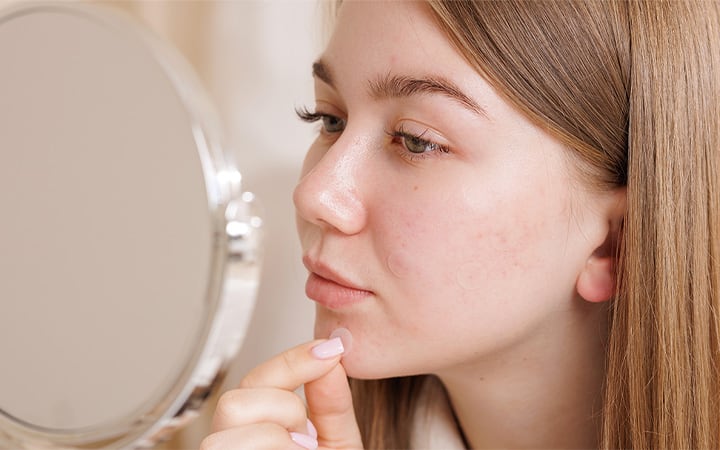Are Pimple Patches Really a Quick Fix for Acne?
September 11, 2025
 University Hospitals Rainbow Babies & Children'sExperts in Children's Health
University Hospitals Rainbow Babies & Children'sExperts in Children's Health

Tweens and teens across the U.S. are driving a skincare trend that’s turned acne treatment into a form of creative self-expression. They’re using pimple patches to manage breakouts and speed up skin healing.
These tiny blemish band-aids may be quite popular, but they aren’t risk-free. “They contain ingredients that people with certain allergies or sensitive skin may want to avoid,” says Kord Honda, MD, a dermatologist and the Director of Dermapathology at University Hospitals Cleveland Medical Center.
How Pimple Patches Work
Hydrocolloid dressings have been around for decades. “We use these dressings to help with wound healing,” says Dr. Honda. A hydrocolloid pimple patch can help heal minor skin troubles, like blemishes, pimples and superficial acne lesions. “Theoretically, they draw out moisture from the area,” he says. “In part, they also serve as a barrier that helps keep people from picking their acne.”
But a pimple patch won’t treat the underlying causes of acne, like clogged pores or hormonal changes, or prevent future breakouts. “The most important thing for acne treatment is preventive medications,” Dr. Honda says.
Types of Pimple Patches
Pimple patches are available in a range of sizes that target different kinds of breakouts, from small individual pimples and blemishes to medium-sized cystic acne. There are also larger patches for body acne that target problem areas on the arms, chest or back.
Some patches are clear and hardly noticeable. Others are decorative, colorful and come in different shapes like circles, stars and hearts. Some are even printed to look like emojis. It’s important to make sure your skin is clean and dry before putting a pimple patch on, and to use the product as directed. “The patch should be replaced daily,” says Dr. Honda.
Most pimple patches fall into three main categories:
- Non-medicated hydrocolloid patch: “This is a patch that has absorbent properties,” says Dr. Honda. It’s made with a hydrocolloid film that gets applied to a small piece of material like a patch or a little sticker. The film forms a gel when it gets moist, which helps soak up fluid from the pimple. It’s typically used for surface-level pimples and whiteheads.
- Medicated patch: This patch is formulated with acne-fighting ingredients. Medicated patches often contain salicylic acid. “Salicylic acid can be helpful for acne, but it’s best for preventing acne, rather than treating individual pimples,” says Dr. Honda. Some medicated patches help spot-treat pimples with other ingredients, like benzoyl peroxide, niacinamide, ceramides, peptides, retinol, bakuchiol or tea tree oil. Medicated patches can be used to target early-stage papules, pustules and nodular or cystic pimples.
- Microneedling patch: These patches are covered on one side with very small dart-like needles that are designed to penetrate the top layer of the skin, target acne-causing bacteria, and then quickly dissolve. “The tiny points are supposed to deliver medication, such as salicylic acid, deeper into the skin,” says Dr. Honda. Microneedling patches can be used on deeper nodular or cystic pimples.
The Hidden Risks
Before you add pimple patches to your skincare routine, it’s important to consider the potential downsides. Even if the spot treatment they provide helps support healing, they’re not a miracle cure for acne. “In general, it’s best to use acne treatments that prevent acne, rather than treat existing acne,” says Dr. Honda. “A dermatologist can advise treatments to help you achieve this goal.”
It’s also not yet clear how these skincare products stack up against traditional acne spot treatments. More research is needed to understand how effective they are at reducing redness, decreasing pimple size, improving skin texture and minimizing inflammation and infection. You may get more for your money if you choose an over-the-counter acne treatment over pricey pimple patches. For example, a benzoyl peroxide spot treatment can be used instead, says Dr. Honda. But again, he emphasizes that “total face treatments that prevent acne are the most effective.”
The biggest risks associated with pimple patches are skin irritation and allergic reactions, particularly for people with sensitive skin or allergies to the patch materials. “The main irritant is likely to be the adhesive,” says Dr. Honda. However, some patches contain latex or other polymers that can trigger allergic reactions, and active ingredients like salicylic acid and tea tree oil may redden or dry sensitive skin, or cause a rash.
“If you experience any negative reactions from pimple patches, you should stop using them immediately,” says Dr. Honda, “and consult a dermatologist if the reaction doesn't resolve quickly.”
Related Links
University Hospitals dermatology and dermatopathology specialists treat a wide range of skin conditions and diseases, including acne treatment, and provide compassionate, individualized care for both adults and children.
Tags: Kord Honda, MD, Skin Health


